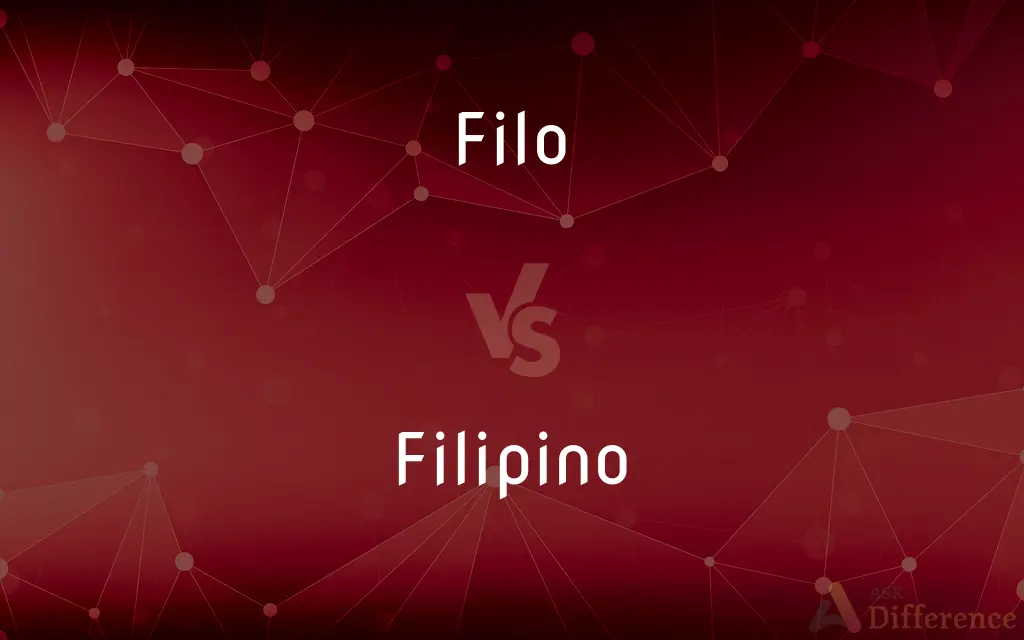Filo vs. Filipino — What's the Difference?
Edited by Tayyaba Rehman — By Fiza Rafique — Updated on March 28, 2024
Filo refers to the thin dough used in pastries, common in Middle Eastern and Balkan cuisines, while Filipino pertains to anything related to the Philippines or its people.

Difference Between Filo and Filipino
Table of Contents
ADVERTISEMENT
Key Differences
Filo, or phyllo, is a very thin unleavened dough used for making pastries like baklava and spanakopita in Middle Eastern and Balkan cuisines. It requires skill to prepare, as it is known for its delicate, flaky texture. On the other hand, Filipino refers to the people of the Philippines, their culture, or anything related to the Philippines, embodying a rich blend of native, Asian, and Spanish influences.
While filo dough is celebrated for its culinary uses, being a staple in many traditional recipes across several cultures, Filipino cuisine itself is diverse, incorporating a variety of ingredients and techniques, not typically involving filo. Filipino food is known for its bold flavors, unique combinations, and historical influences, distinct from the culinary traditions where filo is prevalent.
The preparation of filo dough is a meticulous process that involves stretching the dough into paper-thin sheets, a technique that has been perfected over centuries. In contrast, Filipino culinary practices are characterized by their adaptability and innovation, incorporating local ingredients into dishes influenced by a long history of trade and colonization.
Culturally, filo dough's significance lies in its role in traditional dishes that are often prepared for celebrations and family gatherings, symbolizing communal ties and heritage. Meanwhile, Filipino culture, with its emphasis on family, respect, and community, is expressed through its cuisine, celebrations, and daily life, reflecting a blend of indigenous, Asian, and Spanish influences.
The terminology also reflects geographical and cultural distinctions. "Filo" is derived from the culinary lexicon, specifically referring to a food preparation technique, while "Filipino" denotes a national and ethnic identity, illustrating the diverse and rich cultural landscape of the Philippines.
ADVERTISEMENT
Comparison Chart
Definition
A thin, unleavened dough used in various pastries.
Pertains to anything related to the Philippines or its people.
Origin
Middle Eastern and Balkan cuisines.
The Philippines.
Use
Culinary, specifically in pastries.
Cultural, national, and ethnic identity.
Characteristics
Delicate, flaky texture.
Diverse, embodying a blend of influences.
Significance
Celebratory dishes, tradition.
National identity, culture, cuisine.
Compare with Definitions
Filo
Known for its delicate, flaky texture.
The chef demonstrated how to handle filo to maintain its flakiness.
Filipino
The national language of the Philippines.
The documentary features interviews in Filipino, offering authentic insights.
Filo
A type of very thin dough used in making pastries.
She expertly layered the filo dough to make a delicious baklava.
Filipino
Reflects a unique blend of historical influences.
The architecture in Manila showcases Filipino adaptation of Spanish styles.
Filo
Requires meticulous preparation.
Making filo from scratch involves a lot of patience and skill.
Filipino
Known for vibrant and diverse cuisine.
Filipino dishes, like adobo and sinigang, are celebrated for their bold flavors.
Filo
Used in various Middle Eastern and Balkan dishes.
For our cultural night, we're making a spanakopita with filo.
Filipino
Relating to the Philippines or its people.
Filipino culture is a rich tapestry of native, Asian, and Spanish influences.
Filo
Integral to traditional recipes and celebrations.
Their family recipe for baklava uses homemade filo.
Filipino
Emphasizes family, community, and tradition.
Filipino gatherings often feature an array of traditional dishes.
Filo
Filo or phyllo is a very thin unleavened dough used for making pastries such as baklava and börek in Middle Eastern and Balkan cuisines. Filo-based pastries are made by layering many sheets of filo brushed with oil or butter; the pastry is then baked.
Filipino
Relating to the Philippines, the Filipinos, or their language.
Filo
Variant of phyllo.
Filipino
A native or inhabitant of the Philippines, or a person of Filipino descent.
Filo
Alternative spelling of phyllo
Filipino
The national language of the Philippines, a standardized form of Tagalog.
Filipino
A native or inhabitant of the Philippines.
Filipino
A person of Filipino ancestry.
Filipino
The Austronesian language that is based on Tagalog, draws its lexicon from other Philippine languages, and is the official language of the Philippines.
Filipino
Of or relating to the Philippines or its peoples, languages, or cultures.
Filipino
Of or relating to the Philippines or its people or customs.
Filipino
Of or relating to the language of the Philippines.
Filipino
The official language of the Philippines, based on Tagalog. It draws its lexicon from other Philippine languages.
Filipino
A native or inhabitant of the Philippines
Filipino
Official language of the Philippines; based on Tagalog; draws its lexicon from other Philippine languages
Filipino
Of or relating to or characteristic of the Philippines or its people or customs;
The Philippine President
Our Filipino cook
Common Curiosities
How is filo dough prepared?
Filo dough is prepared by stretching the dough into very thin sheets, a technique requiring skill and patience.
Is filo the same as puff pastry?
No, filo and puff pastry are different; filo is much thinner and doesn't contain the layers of fat that puff pastry does, resulting in different textures.
What languages are spoken in the Philippines?
The Philippines is home to many languages, with Filipino (based on Tagalog) and English being the official languages.
What is filo dough?
Filo dough is a very thin, unleavened dough used in pastries common in Middle Eastern and Balkan cuisines.
What is the historical significance of Filipino cuisine?
Filipino cuisine has a historical significance that includes influences from centuries of trade and colonization, creating a unique blend of tastes and dishes.
What are the main ingredients in filo dough?
The main ingredients in filo dough are flour, water, a little oil, and sometimes vinegar, combined to create a pliable, thin dough.
Can filo dough be used in Filipino cuisine?
While not traditional, filo dough could be creatively incorporated into Filipino recipes by fusion chefs.
What makes Filipino culture unique?
Filipino culture is unique for its blend of native, Asian, and Spanish influences, reflected in its customs, traditions, and cuisine.
Can filo dough be found in the Philippines?
While not traditionally used, filo dough can be found in international markets and used by chefs exploring fusion cuisine in the Philippines.
Who are the Filipino people?
The Filipino people are the nationals or citizens of the Philippines, known for their rich cultural heritage.
What are some traditional Filipino dishes?
Traditional Filipino dishes include adobo, sinigang, lechon, and halo-halo, known for their diverse flavors and ingredients.
How do Filipinos celebrate their culture?
Filipinos celebrate their culture through festivals, family gatherings, and the preparation of traditional dishes, emphasizing community and heritage.
How do Filipino values influence their cuisine?
Filipino values like community, family, and hospitality significantly influence their cuisine, emphasizing shared meals and a variety of dishes.
What is the difference in texture between filo pastries and Filipino pastries?
Filo pastries are known for their flaky texture, while Filipino pastries can range from soft and chewy to dense and rich, depending on the recipe.
How are filo and Filipino cuisine similar?
Both filo and Filipino cuisine value the importance of tradition and community in their culinary practices, although their ingredients and techniques differ.
Share Your Discovery

Previous Comparison
Promotion vs. Transfer
Next Comparison
Masthead vs. TitleAuthor Spotlight
Written by
Fiza RafiqueFiza Rafique is a skilled content writer at AskDifference.com, where she meticulously refines and enhances written pieces. Drawing from her vast editorial expertise, Fiza ensures clarity, accuracy, and precision in every article. Passionate about language, she continually seeks to elevate the quality of content for readers worldwide.
Edited by
Tayyaba RehmanTayyaba Rehman is a distinguished writer, currently serving as a primary contributor to askdifference.com. As a researcher in semantics and etymology, Tayyaba's passion for the complexity of languages and their distinctions has found a perfect home on the platform. Tayyaba delves into the intricacies of language, distinguishing between commonly confused words and phrases, thereby providing clarity for readers worldwide.














































